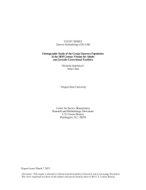
An official website of the United States government
Here’s how you know
Official websites use .gov
A .gov website belongs to an official government organization in the United States.
Secure .gov websites use HTTPS
A lock (
) or https:// means you’ve safely connected to the .gov website. Share sensitive information only on official, secure websites.
-
//
- Census.gov /
- Library /
- Census Working Papers /
- Prisons for Adults and Juvenile Correctional Facilities
Ethnographic Study of the Group Quarters Population in the 2010 Census: Prisons for Adults and Juvenile Correctional Facilities
Ethnographic Study of the Group Quarters Population in the 2010 Census: Prisons for Adults and Juvenile Correctional Facilities
Executive Summary
The purpose of this qualitative study was to explore the factors that shape the ability of the U.S. Census Bureau to accurately count individuals confined to state juvenile correctional facilities and prisons. The preparation and process of the 2010 enumeration was observed at both the agency level and the institution level. The primary agencies and sites included in this study included one state’s Juvenile Authority (JA) and a juvenile correctional facility for females, and the same state’s Department of Corrections (DOC) and four state prisons for men.
In contrast to many other Group Quarters, a primary responsibility of both juvenile correctional facilities and prisons is security and public safety. Thus, the institutions and their central agencies have clear records of which individuals are in which facility at any given time. Virtually all juvenile correctional facilities and state prisons do “counts” at least four times a day (Sykes, 1958; Jacobson-Hardy, 2002; Johnson, 2002; Inderbitzin, 2007), and corrections workers are responsible for keeping close track of the youth or inmates in their units. The challenges of enumerating the population of correctional facilities, then, are generally not in capturing accurate names and numbers of residents in any given institution. Instead, safety concerns and the closed culture of correctional facilities provide the obstacles for enumeration and Census Coverage Measurement (CCM) studies.
Others in Series
Working Paper
Working Paper
Working Paper
Share
Related Information
Some content on this site is available in several different electronic formats. Some of the files may require a plug-in or additional software to view.
 Yes
Yes
 No
NoComments or suggestions?


Top

